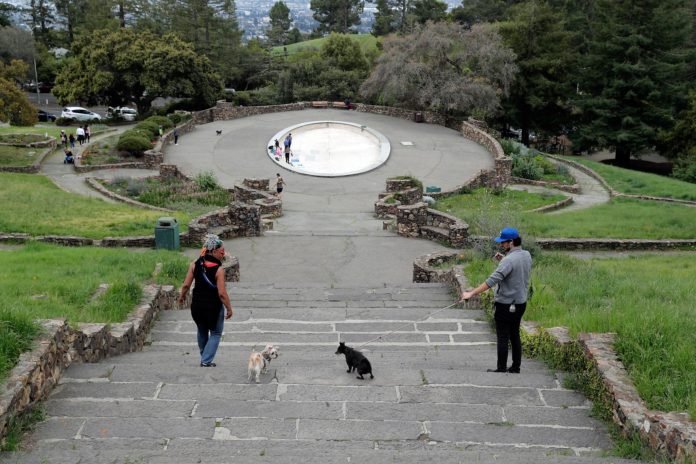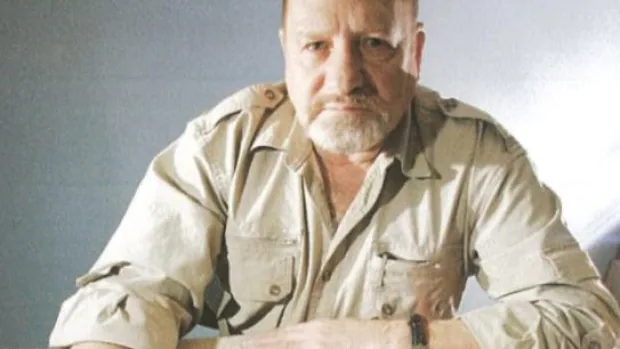In death, Joaquin Miller never got his wish. Hoping to go out in an artistic flourish, the pioneer poet had a funeral pyre built at the highest point of his Oakland Hills estate, and demanded that his only service be the lighting of that fire so his ashes could blow with the wind. (Meddling descendants opted for a tasteful public funeral and cremation. Members of the Bohemian Club scattered his ashes from an urn three months later.)
But an even greater artistic statement would arrive more than 25 years later, on the backs of hundreds of Miller’s Bay Area neighbors, and the Works Progress Administration. Laborers hauled hundreds of tons of stone, shale and marble to the estate, donated to the city as Joaquin Miller Park, and built the Cascade — a network of stone walls, waterfalls, fountains and stairways that ascend into the Woodminster Amphitheater. The Cascade is 80 years old and remains squarely in its prime.
The Works Progress Administration — a federal agency that built public works projects coming out of the Great Depression — was responsible for thousands of fixes, upgrades and wholesale builds in Bay Area streets, sewers and parks. Walk a couple of miles in San Francisco, and you’ll likely pass a dozen WPA projects big and (mostly) small.
But there are several exceptional destinations, where engineering, technology and design combined to create something special and lasting. And they’re more important now than ever — not only as new places to discover during the pandemic, but as a reminder that when the crisis is over, the things we build to be functional will also become works of art.
Here are five Bay Area WPA classics, and how they transcend mere function.
Park Street Bridge
City: Alameda
Construction: 1935
Officials needed a stunt to receive attention when they debuted the Park Street Bridge — one of four bridges over the estuary between Oakland and Alameda, and one of two rebuilt by the WPA. In a reality show-style flourish, the mayors of both towns married Edith Bird of Alameda and Edward Drotleff of Oakland during a ceremony at the center of the bridge.
The drawbridge never needed the publicity. With its steel girders shaped into warm curves, it has become a symbol of pride in the only island city in the Bay Area. And that pride has grown in the last decade. Alameda’s indoor miniature golf course made a hole based on the bridge. The Park Street coffee shop the Local incorporated the bridge into its logo. And shirts with a silhouette of the bridge and the words “The Island” — a play off the Golden State Warriors’ The City logo — are sold in several downtown stores.
The Park Street Bridge is a sign of WPA strength, and it became symbolic of a small town’s unity.

Berkeley Rose Garden
City: Berkeley
Construction: 1933-1937
When Berkeley’s WPA-built rose garden was finished on Sept. 26, 1937, it was as if the community didn’t want it to be discovered. Given the generic let’s-not-make-this-a-destination name, Municipal Rose Garden, the grand opening was announced with one sentence in The Chronicle and no address. More than eight decades later, the garden high in the Berkeley hills remains a well-kept secret (I’ll get at least one letter of complaint for giving up the spot) and one of the loveliest and most unusual Bay Area WPA construction efforts.
The tiered stone garden is built like an amphitheater on a steep grade, as if the dozens of varieties of roses have gathered for a concert. A redwood pergola, currently being rebuilt, forms a half-halo around the space. Now with the slightly more dynamic name Berkeley Rose Garden, it’s a haven for locals, including a robust group of volunteers and visitors of all ages. (We dropped by on a Thursday morning and heard the hide-and-seek words “Ready or not, here I come!” for the first time in a couple of decades.)

Golden Gate Park Fly Casting Pools
City: San Francisco
Construction: 1938-1939
Golden Gate Park is filled with throwback spaces, but it’s hard to find a place or a pastime as transportive as the Golden Gate Angling and Casting Club. Far off the beaten path — encircled by trees and bushes just west of the Polo Field — the casting pools look like a forgotten swimming hole transported from “The Andy Griffith Show.”
But they are in fact world-class pools for fly fishing practice and tournaments, built mostly in 1938 with the support of longtime park superintendent John McLaren, who heard about a WPA fly casting pool in Portland, Ore., and insisted San Francisco create one that was even better.
Designed like a golf driving range for fly fishers, the rectangular pools have platforms and places to wade. There’s no more meditative sight in the park than watching casters silently create swirling artwork in the air as they cast their fishing lines. The WPA-built Anglers Lodge is a rustic anchor to the scene, with its stone patio and beautiful woodworking in the main structure.

Aquatic Park
City: San Francisco
Construction: 1935-1941
Among San Francisco’s WPA projects, Aquatic Park was second in scope and profile only to the San Francisco Zoo. The long-planned bathhouse, park and pier was rescued from construction limbo by the WPA, which provided $1.78 million to finish the project.
Since its 1939 opening, Aquatic Park has served as a casino, military outpost, maritime museum, and finally, a historic park. But it seems to grow in value each passing year, providing both a functional space and lively throwback to a different time in San Francisco.
Through it all the streamline moderne bathhouse remains a classic underrated San Francisco structure, filled with bright sea life murals. The 19th century three-mast sailing ship Balclutha remains docked near the museum, offering a visual counterpoint. And the Municipal Pier, in need of a reinvention, is still an asset for its ghost town vibe.

Joaquin Miller Park Cascade
City: Oakland
Construction: 1935-1940
Miller donated the land that the Cascade rests on, and more artistic locals became involved with the project, including Tribune Tower architect Edward Foulkes (designer of the Woodminster Amphitheater) and Children’s Fairyland designer William Penn Mott (who designed the park).
The stone-and-mortar walls, stairs and giant planters lack firm structure when you’re standing close, looking as if they drifted into the park on a lava flow. But as you climb higher up the stairs and look back toward the three fountains and the beautiful bay views in the distance, the park’s scale is revealed — an incredible monument to hard work. The final climb is a walk past a creek through a woods (it feels like a different microclimate) to the dam-like concrete wall of the Woodminster Amphitheater.
We’ll watch plays there again later. But even in the pandemic, there’s still plenty of art left in Joaquin Miller Park.
Peter Hartlaub is The San Francisco Chronicle’s culture critic. Email: phartlaub@sfchronicle.com Twitter: @PeterHartlaub
Credit: Source link






























